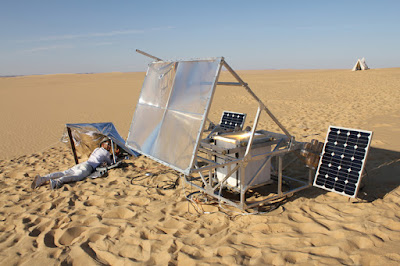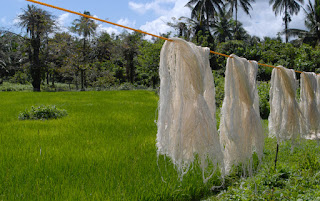Through the lessons and blog research, I become more aware of environmental issues and realized the choose of material could influence environment a lot, especially for the everyday projects. "Agar Plasticity" (replacing plastic by seaweed), "Forest Wool" (using pine needles to produce furniture) and "Pinatex" (using pineapple leaves to produce leather) are three projects I have written about transforming leftover material in an innovative way to generate sustainable designs. They are all environmental-friendly and could biodegrade after use. It inspired me to consider the dispose of materials used for contemporary architecture structures, as what I am studying. I remember seeing "The Smile" from the London design festival in the Parade ground being smashed after exhibited. It would be more sustainable if the structure could be adapted to suit other functions or build by another material which could be easily dissembled and reused.
 |
| "The Smile" from the London design festival |
 |
| Solar Sinter project by Markus Kayser |
 |
| Solar Sinter project by Markus Kayser |
I was really interested in the innovation of 3d printing process and have researched and written few blog posts about it. The 3d printed hair by MIT mediated group is really impressive in the way it is extremely complicated, tactile and soft, while traditional 3d printed projects are hard. The death mask by Nari Oxman using data-driven and 3d printing techniques visualized breath, which is very difficult to capture. The silk pavilion and the pavilion build by 3d printer pen open new possibilities for 3d printing and go beyond the limit of the size of the printer and the layering printing system.
The advantage of using digital technology in design is inevitable. "Based on mathematical functions, the software-generated design allows for the development of new forms of geometries that would be hard if not impossible to conceive or produce with the same precision by means of traditional methods."(Christiane, 2013) I realized that 3d printers are machines. What it will produce depend on how people use it. Human instinct is always vital in the digital design process and machines could be modified or developed depends on human needs.
Overall, by browsing through design websites to search up-to-date projects for my blog, I realized sustainability and digital processing seems indispensable in all design discplines. The innovative materials and methods really challenged my preconceived notions of value. I started to questioning the possibly usual combination of material and objects. As for spatial design, materials are the most important components and I always go to the material I used to, like timber and concrete. However, experimental materials may create surprise, especially for the model. Furthermore, I really hope one day I will have the opportunity to experiment with digital devices in design. I think it will open a lot of possibilities in terms of ascetics and functions.
Reference
Christiane, P. (2013). Objecthoods From the Desktop. In: T. Ronald, ed., Out of Hand: Materializing the Postdigital, 1st ed. London: Black Dog Publishing Limited, p.10.
Labaco, R. (2013). Out of hand. 1st ed. London: Black Dog Publishing, p.40.




























